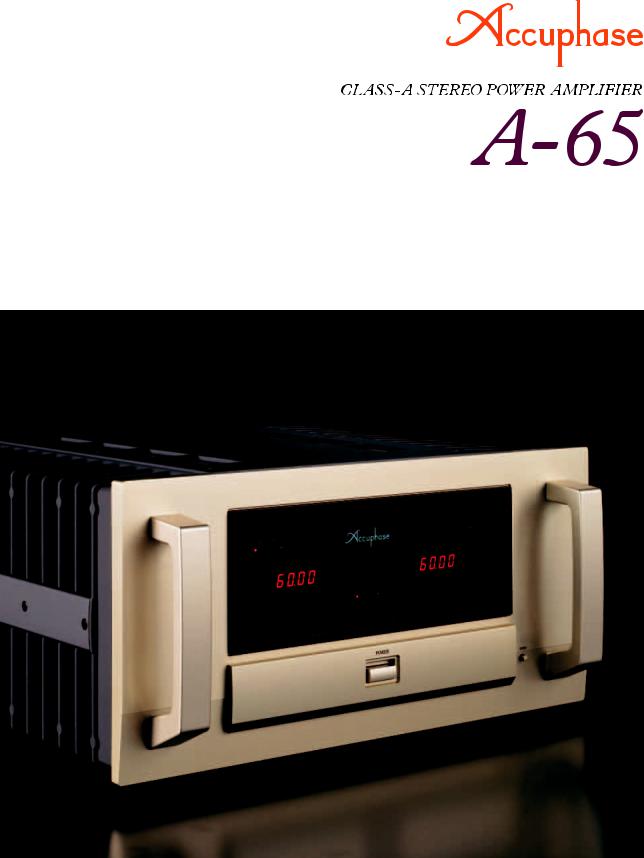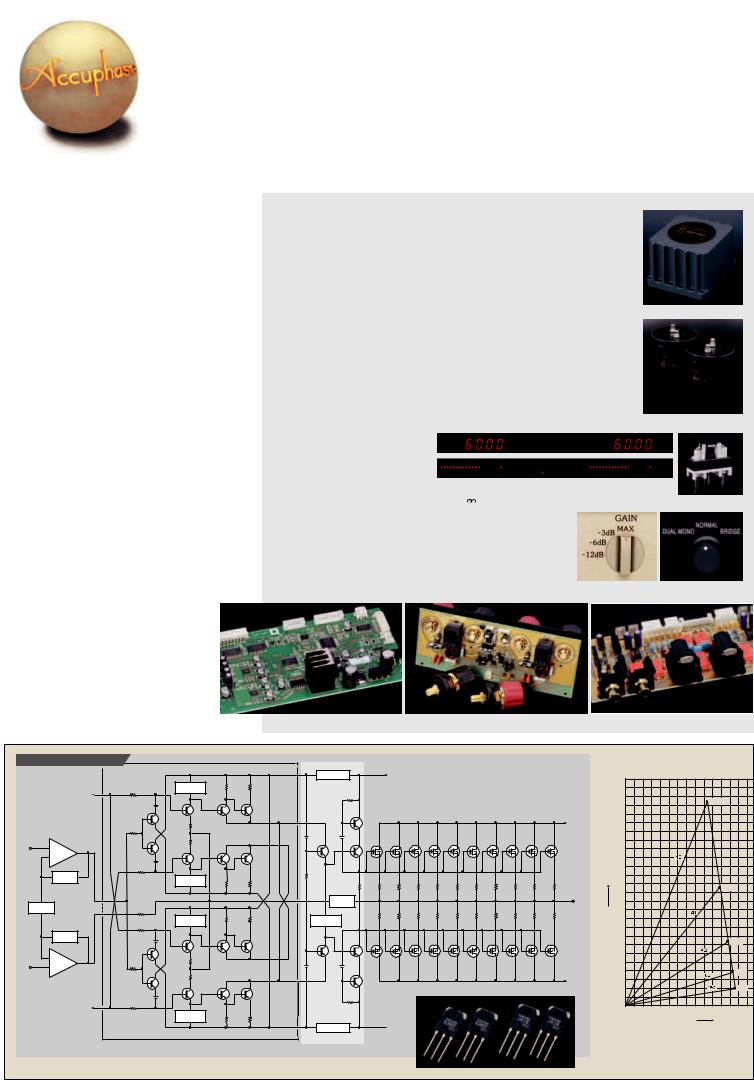Accuphase A-65 Brochure

m Pure Class A operation delivers quality power: 60 watts × 2 into 8 ohms m Power MOS-FET output stage features 10-parallel push-pull configuration and delivers linear high power progression to ultra-low 1-ohm impedances m Input section configured as instrumentation amplifier m Further improved MCS+ circuit in amplifier section m Current feedback topology combines stable operation with outstanding sound m Bridged mode allows upgrading to monophonic amplifier m Two selectable meter types: digital power meters showing true power values and bar graph indicators

Pure Class A power amplifier with power MOS-FET devices — Input stage features fully balanced signal paths as found in high-quality instrumentation amplifiers. Further refined MCS+ topology and current feedback result in superb sound quality and outstanding performance parameters. Strong power supply section and power MOS-FET devices in ten-parallel push-pull configuration sustain linear power output progression down to impedances as low as 1 ohm. Digital power meters show true power readings.
The combination of pure class A and power MOS-FET devices to realize high output power with excellent sonic purity is a domain where Accuphase excels. Models such as the A-100, A-50V, and A-60 have achieved legendary status among audiophiles and represent an unrivaled level of technological excellence. As a model-change successor to the A-60, the new A-65 incorporates accumulated Accuphase know-how while featuring a number of further improvements. The input stage is configured as an instrumentation amplifier to allow fully balanced input signal paths. The further refined MCS+ topology pushes noise and distortion down to absolutely minimal levels, and strictly selected materials and parts of the highest quality are used throughout. The end result is a high-end class A stereo amplifier with simply stunning performance and sound quality.
The output stage of the A-65 features power MOS-FETs renowned for their excellent sound and superior reliability. For each channel, ten of these devices are arranged in a parallel push-pull arrangement. MOS-FETs have excellent frequency characteristics, and their high input impedance reduces the load imposed on the preceding drive stage. They also have negative thermal characteristics, which ensures perfect operation stability. Driving these devices in pure class A produces rich, high-definition sound that brings out the finest nuances in the music. In a pure class A amplifier, the power provided by the power supply is always constant, regardless of the presence of a musical signal. This means that the amplifier remains unaffected by fluctuations in voltage and other external influences.
On the other hand, it also means that the output stage generates considerable thermal energy. In the A-65, this is dissipated effectively by large heat sinks which
provide ample capacity to remove the heat produced by the internal circuitry. The high-efficiency toroidal power transformer housed in an aluminum diecast enclosure, in conjunction with amply dimensioned smoothing capacitors, provides the muscle to deliver an astonishing 480 watts per channel into a 1-ohm load (music signals only). If even higher power reserves are required, bridged mode turns the A-65 into a superlative monophonic power amplifier.
nPower modules with 10-parallel push-pull arrangement of power MOS-FETs deliver 480 watts per channel into 1 ohm (music signals), 240 watts into 2 ohms, 120 watts into 4 ohms, or 60 watts into 8 ohms.
n Strong power supply with high-efficiency toroidal transformer and two extra-large 82,000 μF filtering capacitors.
n Bridged mode supports upgrading to monophonic amplifier with 960 watts into 2 ohms (music signals), 480 watts into 4 ohms, or 240 watts into 8 ohms.
nInstrumentation amplifier principle allows fully balanced signal paths, and current feedback amplifier topology drastically improves S/N ratio.
n Four gain control settings (MAX, –3 dB, –6 dB, –12 dB) minimize residual noise.
n Fully balanced input stage shuts out external noise interference.
nDual mode power meters, switchable to 5-digit numeric readout or 25-point LED bar graph indication.
●Meter circuit ON/OFF switch.
●Digital power meters show true output power values, based on output current detected by a Hall element.
●Peak value hold time settings: 1 second, .
Toroidal power transformer
Filtering capacitors
Hall element
n Input selector button (balanced/unbalanced) on front
panel. |
|
|
n Mode selector with dual mono position supports bi- |
|
|
amping. |
|
|
n Oversize speaker terminals accept also Y lugs. |
Gain selector |
Mode selector |
Meter circuitry/control circuitry assembly |
Large speaker terminals Unbalanced and balanced input connectors |
Instrumentation amplifier |
|
|
|
|
|
|
|
|
|
|
|
|
|
|
|
|
|
|
|
|
|
|
|
||
|
|
|
|
|
REGULATOR |
|
|
+ B1 |
|
|
|
|
|
|
|
|
|
|
|
|
|
|
|
|
|
|
|
Bias stabilizer |
|
|
|
|
|
|
|
|
|
|
|
|
|
|
|
25 |
|
|
|
|
|
|
|
|
|
circuit |
|
|
|
|
|
|
|
|
|
|
|
|
|
|
|
|
|
|
|
|
|
|
|
|
|
+ B3 |
|
|
|
|
|
|
|
|
10-parallel push-pull |
|
|
|
|
|
|
|
|
|
|
|
|||
|
|
|
|
|
|
|
|
|
|
|
|
|
|
|
|
|
|
|
547W |
|
|
||||
|
|
Q1 |
|
|
|
Q19 |
|
|
|
|
power MOS-FET array |
|
+ B2 |
|
|
|
|
|
|
|
|
|
|||
|
|
Q5 |
Q9 |
Q13 |
|
|
|
|
|
|
|
|
|
|
|
|
|
|
|
|
|
|
|
|
|
|
|
|
|
|
|
|
|
|
|
|
|
|
|
|
|
|
|
|
|
|
|
|
|||
|
|
|
|
|
|
|
|
|
|
|
|
|
|
|
|
|
|
20 |
|
|
|
|
|
|
|
|
+ |
|
|
|
Q17 |
Q21 |
Q23 |
Q25 |
Q27 |
Q29 |
Q31 |
Q33 |
Q35 |
Q37 |
Q39 |
Q41 |
|
|
|
|
|
|
|
|
|
+INPUT |
Q7 |
Q11 |
Q15 |
|
|
|
|
|
|
|
|
|
|
|
|
|
|
|
|
|
|
|
|
|
|
- |
Q3 |
|
|
|
|
|
|
|
|
|
|
|
|
|
|
|
|
|
|
|
|
|
|
|
|
|
|
|
|
|
|
|
|
|
|
|
|
|
|
|
|
|
|
|
|
|
|
|
|
|
|
|
NFB |
Bias stabilizer |
|
|
|
|
|
|
|
|
|
|
|
|
|
|
|
15 |
|
|
|
|
|
|
|
|
NETWORK |
|
|
|
|
|
|
|
|
|
|
|
|
|
|
|
|
|
|
|
|
|
|
|
|
|
|
circuit |
|
|
|
|
|
|
|
|
|
|
|
|
|
|
|
|
|
|
|
|
|
365W |
|
|
|
|
|
|
|
|
|
|
|
|
|
|
|
|
|
|
|
|
|
|
|
|
|
|
|
|
|
|
|
|
NFB |
|
|
|
|
|
|
|
|
|
|
|
|
|
|
|
|
|
|
|
|
GAIN |
|
|
|
|
NETWORK |
|
|
|
|
|
|
|
|
|
OUTPUT |
|
|
|
|
|
|
|
|
|
|
CONTROL |
|
|
|
|
|
|
|
|
|
|
|
|
|
|
|
|
(A) |
|
|
|
|
|
|
|
|
|
|
Bias stabilizer |
|
|
Bias stabilizer |
|
|
|
|
|
|
|
|
|
|
|
10 |
|
|
|
|
|
|
|
|
|
NFB |
|
|
|
|
|
|
|
|
|
|
|
|
|
current |
|
|
|
|
|
|
|
|||
|
circuit |
|
|
circuit |
|
|
|
|
|
|
|
|
|
|
|
|
|
|
|
|
|
|
|
||
|
NETWORK |
Q6 |
Q10 |
Q14 |
|
|
|
|
|
|
|
|
|
|
|
|
Output |
|
|
|
|
|
|
214W |
|
|
|
Q2 |
|
|
|
|
|
|
|
|
|
|
|
|
|
|
|
|
|
|
|
|
|
|
|
|
- |
|
|
|
Q18 |
Q20 |
Q24 |
Q26 |
Q28 |
Q30 |
Q32 |
Q34 |
Q36 |
Q38 |
Q40 |
Q42 |
|
5 |
|
|
|
|
|
|
|
|
+ |
|
|
|
|
|
|
|
|
|
|
|
|
|
|
|
|
|
|
|
|
|
|
|
|
-INPUT |
|
|
|
|
|
|
|
|
|
|
|
|
|
|
|
|
|
|
|
|
|
|
|
118W |
|
|
|
|
|
|
|
|
|
|
|
|
|
|
|
|
- B2 |
|
|
|
|
|
|
|
|
||
|
|
Q8 |
Q12 |
Q16 |
|
|
|
|
|
|
|
|
|
|
|
|
|
|
|
|
|
|
|
|
|
|
|
|
|
|
|
|
|
|
|
|
|
|
|
|
|
|
|
|
|
|
|
61W |
|||
|
|
Q4 |
|
|
|
Q22 |
|
|
|
|
|
|
|
|
|
|
|
|
|
|
|
|
|
|
|
|
|
- B3 |
|
|
|
|
|
|
|
|
|
|
|
|
|
|
|
0 |
|
|
|
|
|
|
|
|
|
|
|
|
|
|
|
|
|
|
|
|
|
|
|
|
0 |
5 |
10 |
15 |
20 |
25 |
30 |
35 |
|
|
|
Bias stabilizer |
|
|
|
|
|
|
|
|
|
|
|
|
|
|
|
||||||||
|
|
circuit |
|
|
|
|
|
|
|
|
|
|
|
|
|
|
|
|
Output voltage (V) |
|
|
|
|||
|
|
|
|
|
|
|
|
- B1 |
|
|
|
|
|
|
|
|
|
|
|
|
|
||||
|
|
|
|
|
REGULATOR |
|
|
|
|
|
|
|
|
|
|
|
|
|
|
|
1-ohm operation p |
||||
|
|
|
|
|
|
|
|
|
|
|
|
|
|
|
|
|
|
|
|
|
|
||||
Gain control |
MCS+ (MultipleCircuit Summing) |
|
|
|
|
|
|
|
|
|
|
|
|
|
|
|
|
|
with music signal |
||||||
|
|
|
|
|
|
|
|
|
|
|
|
Figure 2 Load impedance vs. output |
|||||||||||||
|
|
|
|
|
|
|
|
|
|
|
|
|
|
|
|
|
|||||||||
|
|
Figure 1 Circuit diagram of amplifier section (one channel) |
|
|
|
|
|
|
|
|
Power MOS-FETs |
|
|
|
(output voltage/output curr |
||||||||||
|
|
|
|
|
|
|
|
|
|
|
|
|
|
|
|
|
|
|
|||||||
